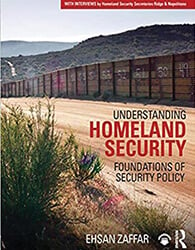Book Review: Understanding Homeland Security: Foundations of Security Policy
By Ehsan Zaffar. Routledge; Routledge.com; 568 pages; $39.95.
 Author Ehsan Zaffar presents a broad-based and intelligent overview of homeland security in the United States throughout his book Understanding Homeland Security: Foundations of Security Policy. The book is well-organized, well-written, and easy to follow.
Author Ehsan Zaffar presents a broad-based and intelligent overview of homeland security in the United States throughout his book Understanding Homeland Security: Foundations of Security Policy. The book is well-organized, well-written, and easy to follow.
The publication covers historical factors of homeland security (both before and after the seminal events of 9/11), complicated concepts pertaining to immigration, the protection of the U.S. borders (including assessing and mitigating risks), and topics pertaining to intelligence gathering, cybersecurity, legal concepts, civil rights and civil liberties, and protection methodology for organizational sectors including transportation and critical infrastructures. In addition to this content, the author also presents impressive “added content” through question-and-answer sections from a wide range of experts, including law enforcement and security industry professionals, academics, and two former U.S. secretaries of homeland security (Tom Ridge and Janet Napolitano). The scope of general knowledge of the book is impressive.
Although the book includes excellent information from governmental and law enforcement sources, it lacks a global view of protection and terrorism. The reader needs to understand that the book revolves around the American protection of the homeland and is not a worldwide review or report of such issues. Equally important is that the book offers the reader little information regarding how the private security sector contributes to the defense of the homeland. If the reader is seeking a global or security industry content, this book will not satisfy their needs.
Intended as a college-level textbook, the volume makes an adequate primer that highlights key terms, poses thought-provoking questions, and delivers intriguing and informational pictures and figures in each chapter. It would be appropriate for mid-level undergraduate (200 and 300 level) students. The publisher offers the book in hardcover, softcover, and electronic formats. Also important is that publisher promotes instructor resources, assisting in course preparation. The security professional may not find much useful or specific information other than a wide review of topics and general information pertaining to the governmental management of infrastructure in protecting the American homeland.
In summary, Understanding Homeland Security: Foundations of Security Policy is a useful exploration of American homeland security protection and appropriate supportive concepts intended for undergraduate academic use.
Reviewer: Joseph Jaksa, CPP, is a professor of criminal justice at Michigan’s Saginaw Valley State University and is a member of ASIS International.